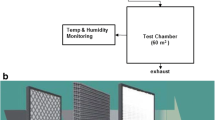Abstract
The mass-transfer coefficient of a free-fall cascade-aeratorunit of 15 million litres per day was evaluated for its efficiency in the removal of a class of volatile organics, the trihalomethanes(THMs). These compounds are carcinogenic and occur as a resultof chlorination of natural waters. Due to the volatile nature ofthe THMs, the efficiency of aeration as a potential techniquefor their removal has been studied. The principle behindaeration is gas-transfer, according to which the gas-liquidinterface is hypothesized to consist of a gas and liquid filmthrough which gas is transferred by molecular diffusion untilequilibrium is attained. The overall mass transfer coefficient(K L) of the aerator considering oxygen as the reference compound, was found to be29.3 hr-1 for THMs.
Similar content being viewed by others
References
Bhole, A. G.: 1975, ‘Design of water treatment plants Paper-I’, J. Indian Water Works Assoc. 3(2), 129.
Gowda, T. P. H. and Lock, D. J.: 1985, ‘Volatization rates of organic chemicals of public health concern’, J. Environ. Eng. ASCE 3(6), 755.
Guruswamy, R.: 1972, Design of Sanitary Engineering Systems, Guindy, Madras.
Lewis, W. K. and Whitman, W. G.: 1924, ‘Principles of gas absorption’, Ind. Eng. Chem. 16(12), 1215–1220.
Metcalf and Eddy, In C.: 1995, revised by Tchobanoglous and Burton, F. L., Waste Water Engineering, 3rd ed., Tata McGraw-Hill Publishing Company Limited, New Delhi, India.
Rainwater, K. A. and Holley, E. R.: 1984, ‘Laboratory studies on hydrocarbon tracer gases’, J. Environ. Eng., ASCE.
Roberts, P.V. and Danliker, P. G.: 1983, ‘Mass transfer of volatile organic contaminants from aqueous solution to atmosphere during surface aeration’, Environ. Sci. Techn. 17(8), 484–489.
Rook, J. J.: 1974, ‘Formation of haloforms during chlorination of natural waters’, J. Water Treatment Exam. 23, 234–243.
Standard Methods for the Examination of Water and Wastewater: 1992, APHA, AWWA, WPCF Washington D.C., 18th ed.
Thacker, N. P., Kaur, P. and Rudra, A.: 1997, ‘Halogenated compounds in and around Nagpur City water resources, India’, Int. Environ. Educ. Inf. 16(4), 367–376.
Trussell, R. R. and Umpheres, M. D.: 1978, ‘The formation of trihalomethanes’, J. Amer. Water Works Assoc. 70, 604–612.
World Health Organization: 1984, Guidelines for Drinking Water Quality 1, p. 76.
Author information
Authors and Affiliations
Corresponding author
Rights and permissions
About this article
Cite this article
Thacker, N.P., Katkar, S.L. & Rudra, A. Evaluation of Mass-Transfer Coefficient of Free Fall – Cascade-Aerator. Environ Monit Assess 74, 1–9 (2002). https://doi.org/10.1023/A:1013809819910
Issue Date:
DOI: https://doi.org/10.1023/A:1013809819910




